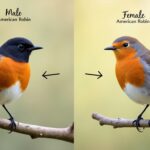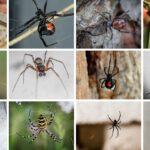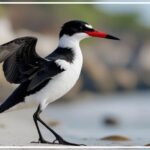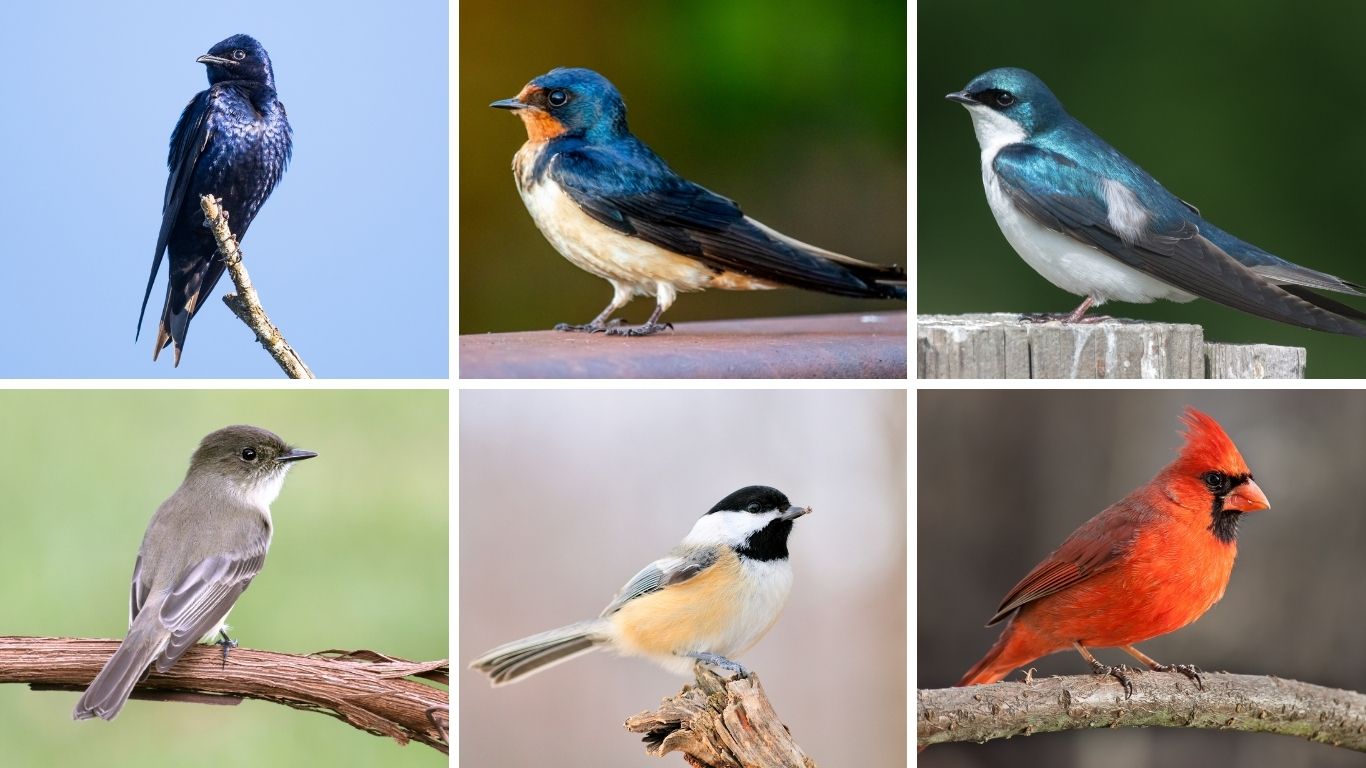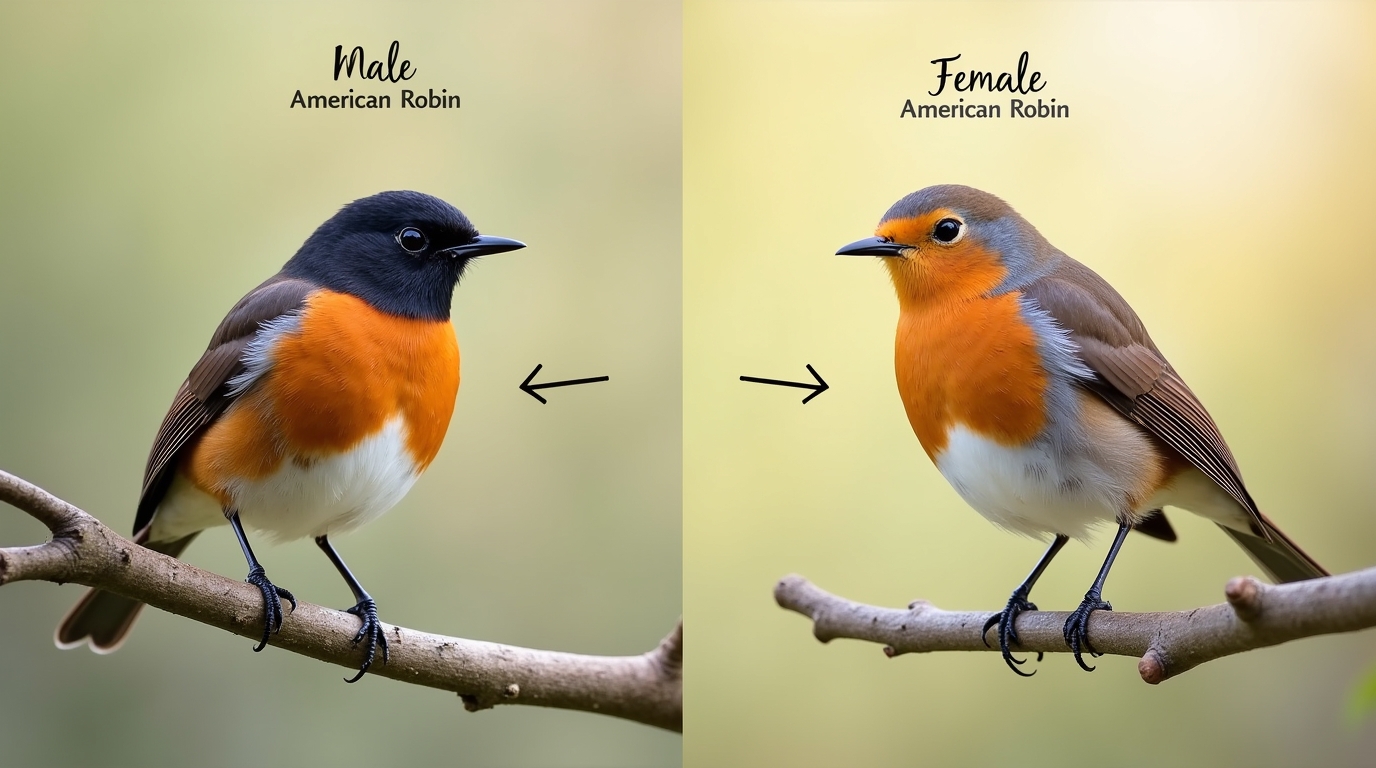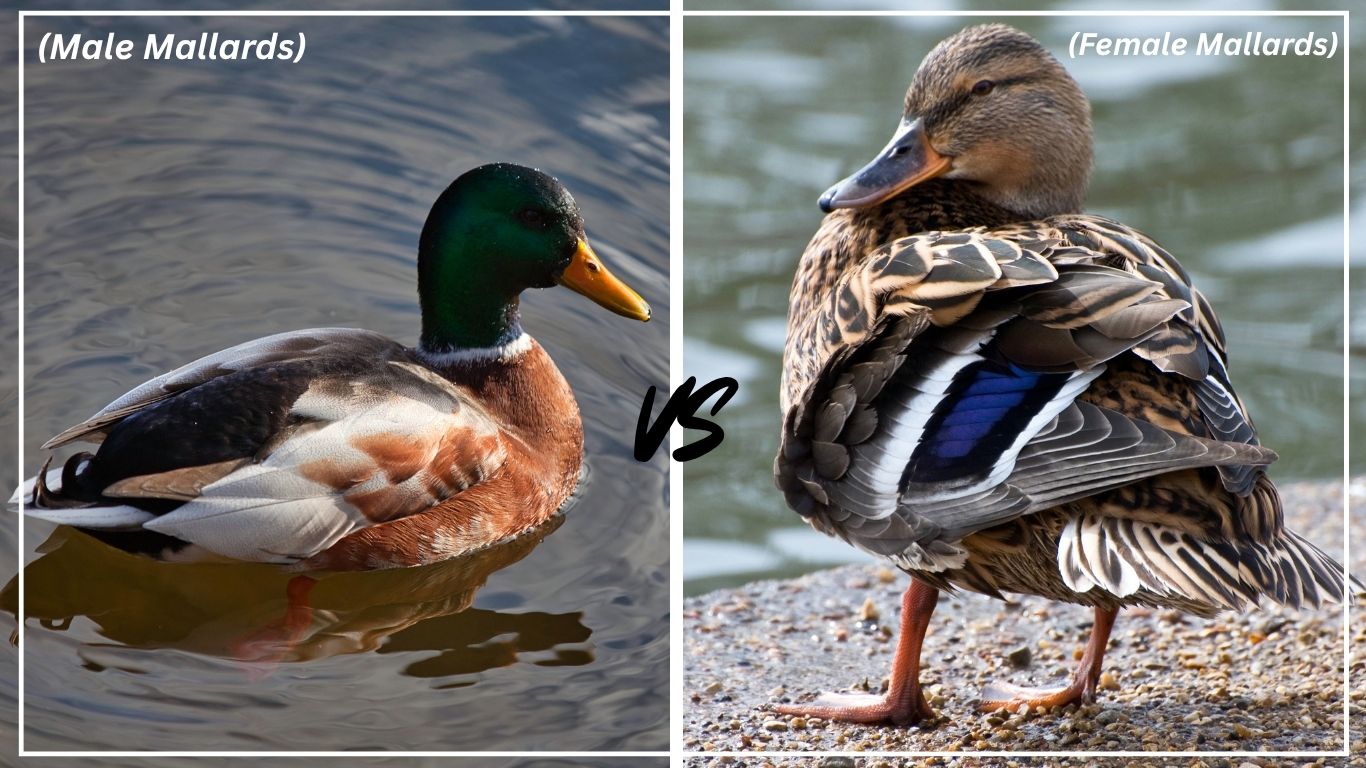Tired of mosquitoes in your backyard? Nature has a built-in solution — birds. Many common birds feed on mosquitoes and help reduce their numbers naturally. Whether it’s during daytime flights or nighttime foraging, these insect-eating birds play a vital role in controlling mosquito populations. In this guide, you’ll discover 15 birds that feast on mosquitoes and learn how they help keep your outdoor space more comfortable and bite-free.
1. Purple Martin
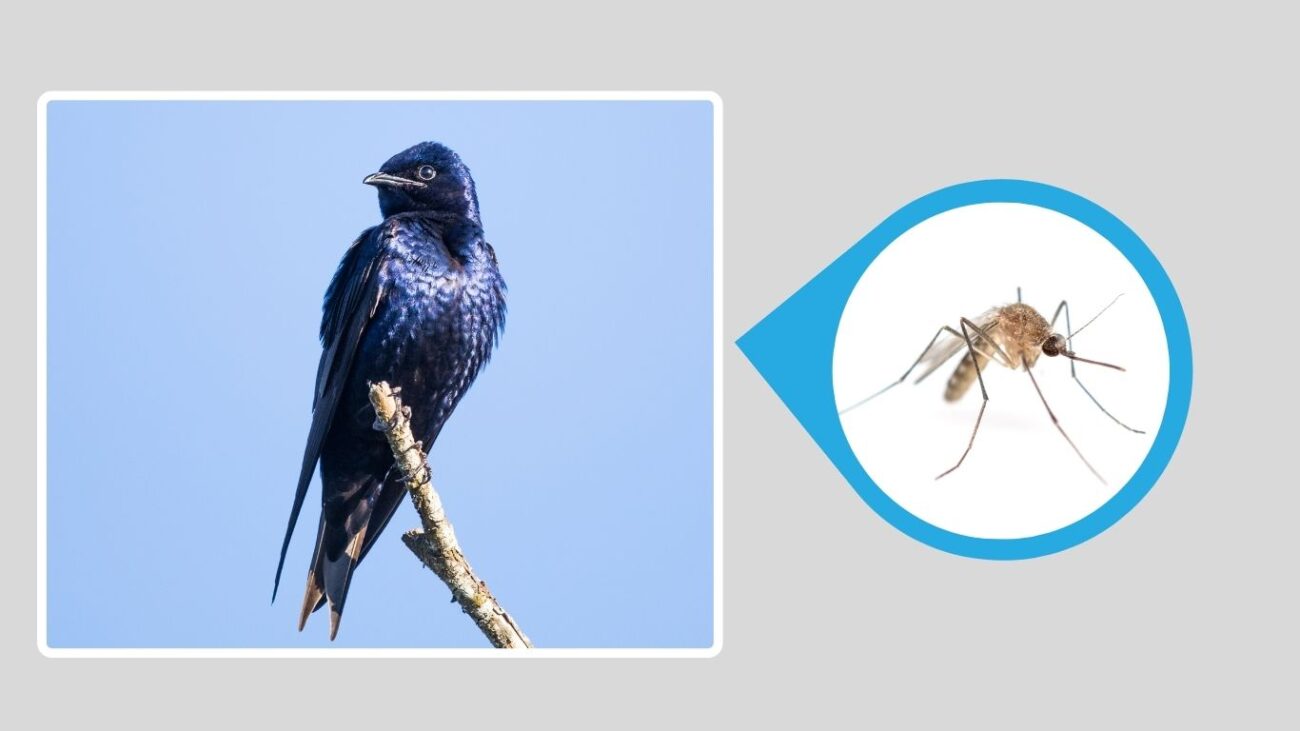
The Purple Martin is a highly effective mosquito predator and one of the largest members of the swallow family. These agile fliers are beloved by bird enthusiasts for their mosquito-hunting abilities and social nesting habits.
Identification and Appearance
- Male: Shiny, iridescent dark blue-purple feathers with slightly forked tail
- Female: Duller with grayish underparts and a bluish back
- Sleek body and long, pointed wings built for fast flight
- Chirpy, bubbly vocalizations
Feeding Habits and Mosquito Diet
Purple Martins feed entirely on flying insects caught midair — including mosquitoes, flies, beetles, and moths. While mosquitoes are a small portion of their diet, their constant aerial foraging helps reduce local insect populations.
When and Where They Hunt
They are most active during daylight hours, especially in the early morning and late afternoon. Martins feed while soaring and gliding at high speeds over open fields, lakes, and near human settlements.
2. Barn Swallow
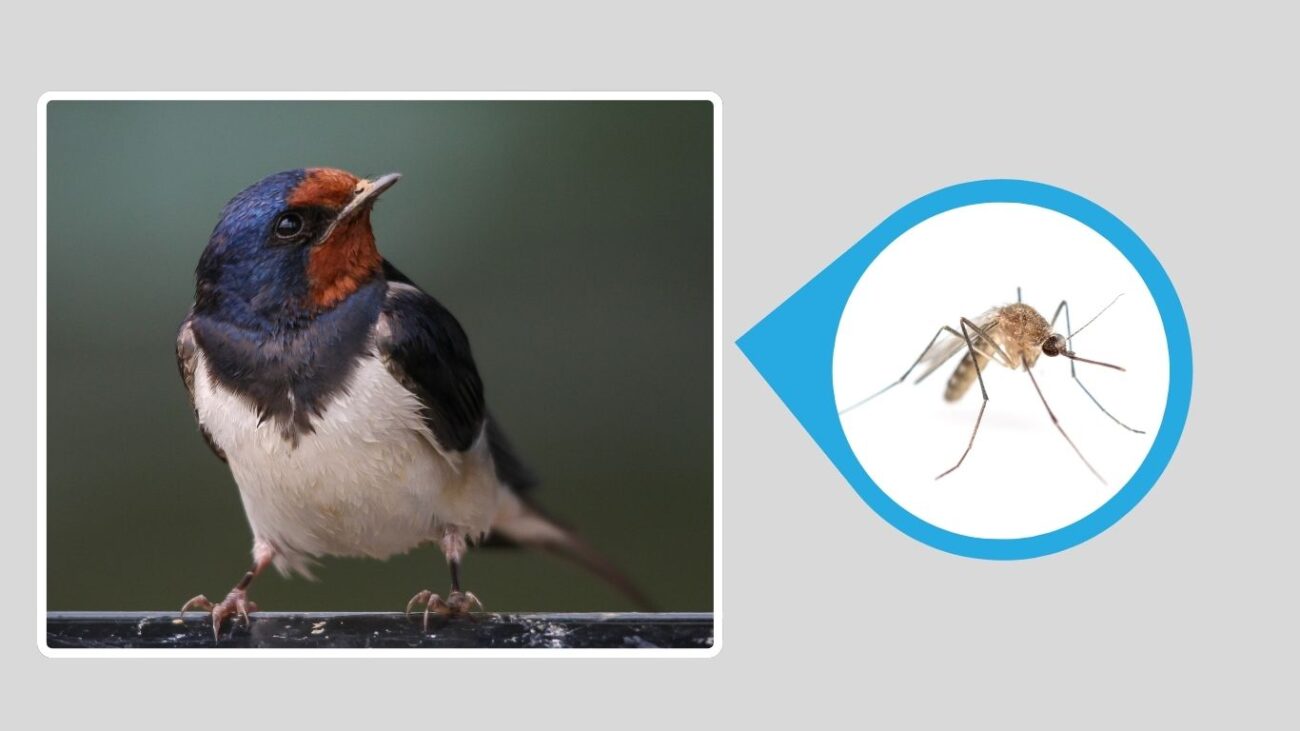
The Barn Swallow is a graceful and acrobatic flyer known for snatching insects, including mosquitoes, while gliding low over fields and water. Their forked tails and streamlined bodies make them expert hunters in flight.
Identification and Appearance
- Glossy blue back, wings, and tail
- Reddish-orange throat and forehead
- Cream to buff underparts
- Long, deeply forked tail with white spots
Feeding Habits and Mosquito Diet
Barn Swallows feed almost entirely on flying insects. They catch mosquitoes in midair with precision, especially during warmer months when insects are abundant.
When and Where They Hunt
These birds hunt mostly during the day but may continue feeding at dusk. They fly low over grasslands, water surfaces, and open areas to catch mosquitoes and other insects on the wing.
3. Tree Swallow
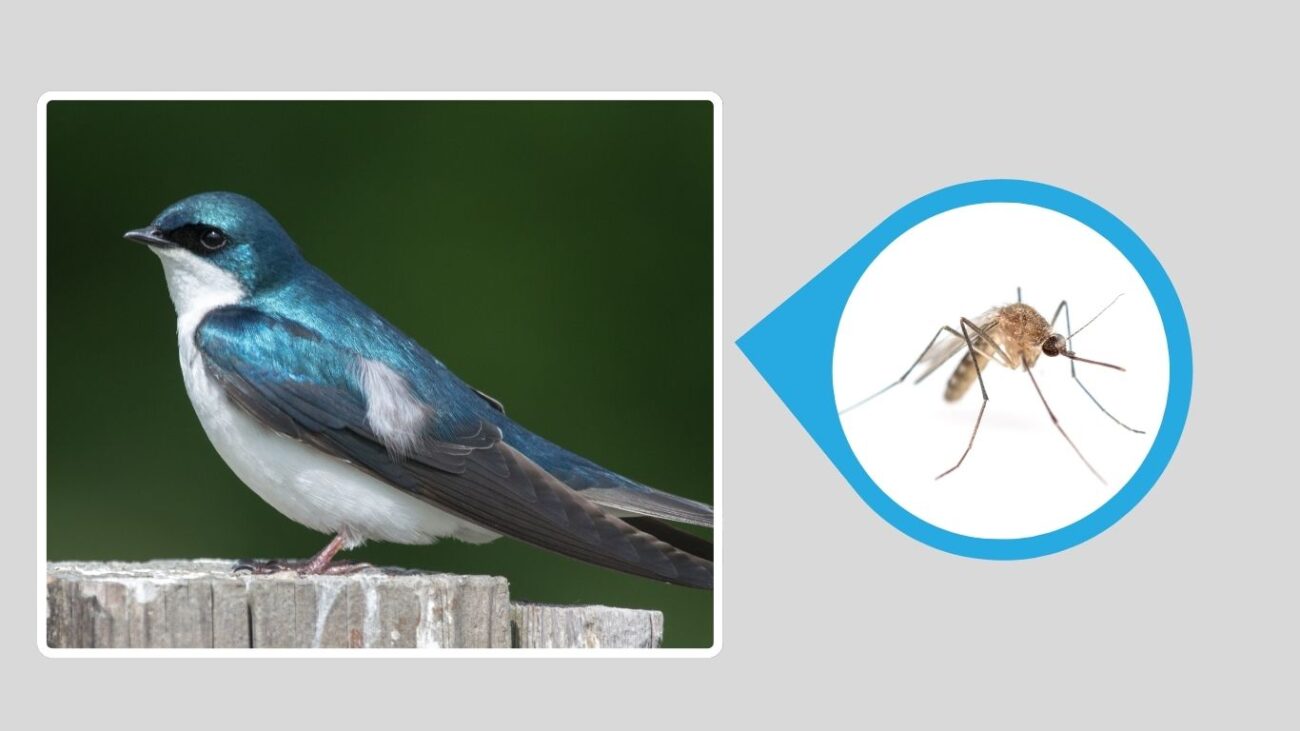
The Tree Swallow is another insect-hunting specialist that targets mosquitoes and other flying bugs throughout the warmer seasons. They are commonly seen darting through the sky with agile, twisting flights.
Identification and Appearance
- Shiny blue-green back and head
- White throat, chest, and belly
- Long, pointed wings and slightly forked tail
- Sleek and compact body
Feeding Habits and Mosquito Diet
Tree Swallows consume large numbers of flying insects, including mosquitoes, midges, and flies. They feed on the wing, often skimming just above water or open grasslands.
When and Where They Hunt
Active during the day and especially around dawn and dusk. They often feed in flocks, maximizing their efficiency in controlling mosquito populations in natural areas.
4. Eastern Phoebe
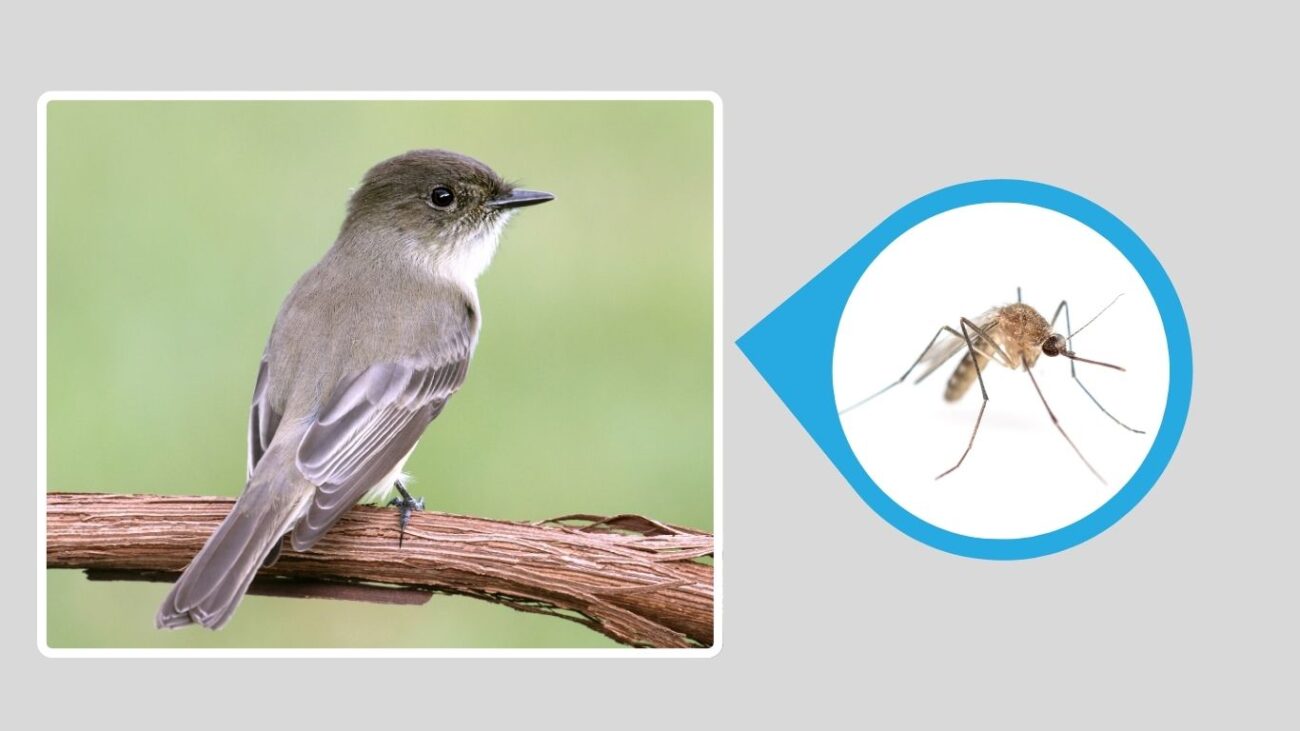
The Eastern Phoebe is a small, active flycatcher that hunts mosquitoes and other flying insects from low perches. It frequently returns to the same spot after short flights to snatch prey midair.
Identification and Appearance
- Grayish-brown upperparts and pale underparts
- Slightly darker head with no bold markings
- Constant tail-wagging behavior
- Short, thin bill suited for catching insects
Feeding Habits and Mosquito Diet
Eastern Phoebes feed on a variety of flying insects, including mosquitoes. They use a “sallying” technique — launching from a perch, catching insects in flight, and returning to the same spot.
When and Where They Hunt
They are active from sunrise to sunset, especially in the early morning and late afternoon. Most foraging takes place near wooded edges, meadows, and gardens with ample insect activity.
5. Black-capped Chickadee

While not known for eating flying insects midair, the Black-capped Chickadee helps control mosquito populations by feeding on larvae and pupae found in hidden or damp areas.
Identification and Appearance
- Black cap and bib with white cheeks
- Soft gray back and wings
- Buff-colored sides and rounded body
- Small, active bird with a cheerful “chick-a-dee-dee-dee” call
Feeding Habits and Mosquito Diet
These birds forage by hopping along branches and foliage, picking off insect eggs, larvae, and pupae — including those of mosquitoes. Their hunting is methodical and often done in shaded, damp areas where mosquitoes breed.
When and Where They Hunt
Chickadees forage all day, especially in early morning and late afternoon. They are most effective around still water and dense foliage where mosquitoes are likely to lay eggs.
6. Northern Cardinal
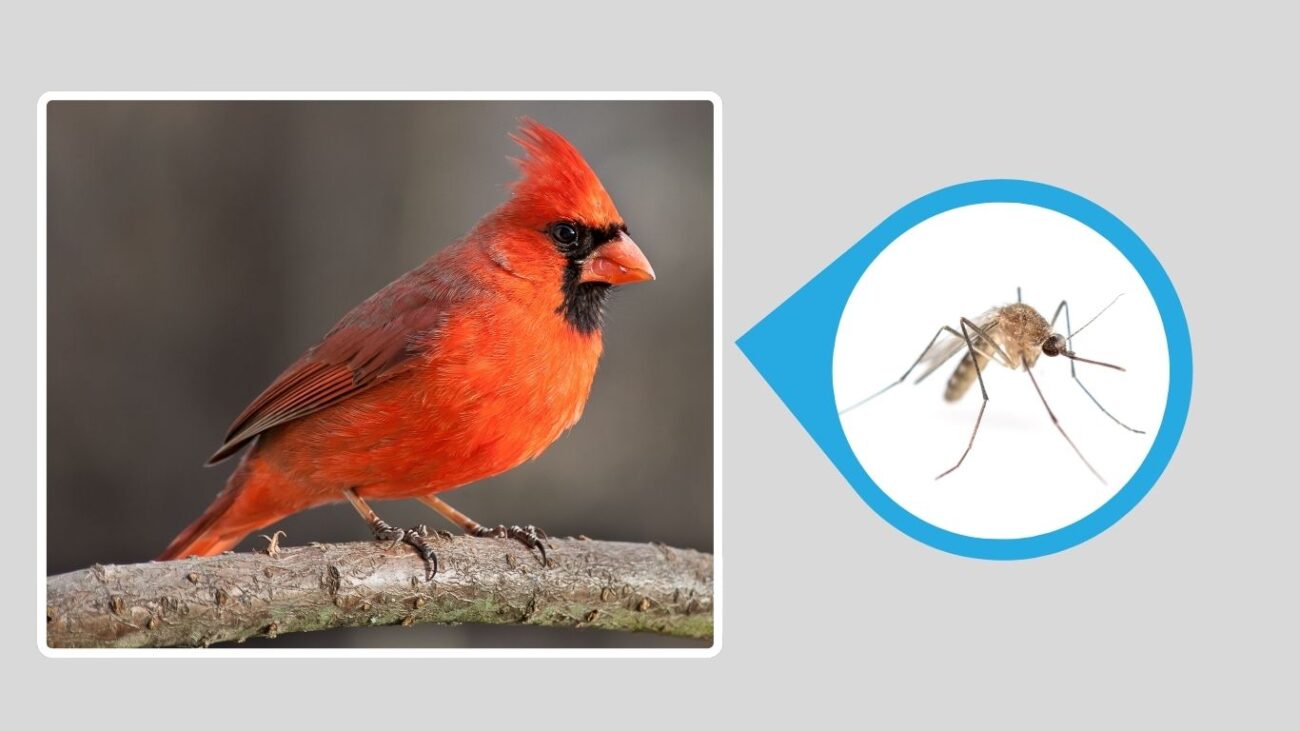
The Northern Cardinal, while primarily known for its seed-based diet, also consumes insects — including mosquitoes — especially during the breeding season when protein-rich food is essential.
Identification and Appearance
- Male: Bright red body with black face mask
- Female: Pale brown with red tinges on wings and crest
- Both have a prominent crest and thick orange beak
Feeding Habits and Mosquito Diet
Cardinals feed on a variety of insects such as beetles, caterpillars, and mosquitoes, especially when feeding chicks. Though not aerial hunters, they snap up mosquitoes resting on leaves or hovering near ground level.
When and Where They Hunt
They forage mainly during early morning and evening in dense shrubs, gardens, and forest edges. Their hunting is deliberate and ground-focused rather than high-speed flight.
7. House Wren
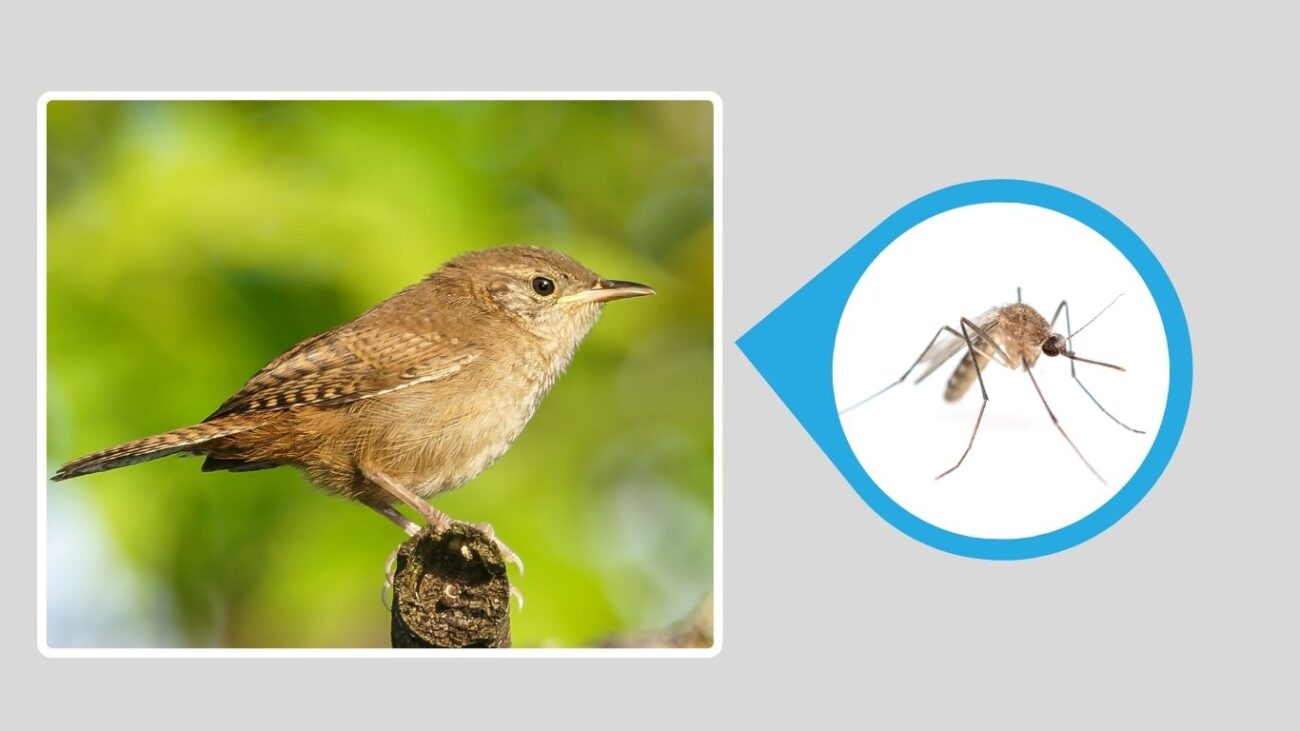
The House Wren is a small, energetic bird known for its insect-hunting skills. It plays a big role in natural mosquito control by eating both flying adults and hidden larvae.
Identification and Appearance
- Small, brown bird with faint barring on wings and tail
- Short tail often held upright
- Slender bill and expressive eyes
- Fast, bubbly song
Feeding Habits and Mosquito Diet
House Wrens consume a wide range of insects, including mosquitoes, spiders, beetles, and larvae. They are constantly on the move, probing crevices and low vegetation for hidden prey.
When and Where They Hunt
Active throughout the day, especially early morning and near dusk. Wrens forage in gardens, brush piles, woodpiles, and low shrubs where mosquitoes often rest or breed.
8. Eastern Kingbird
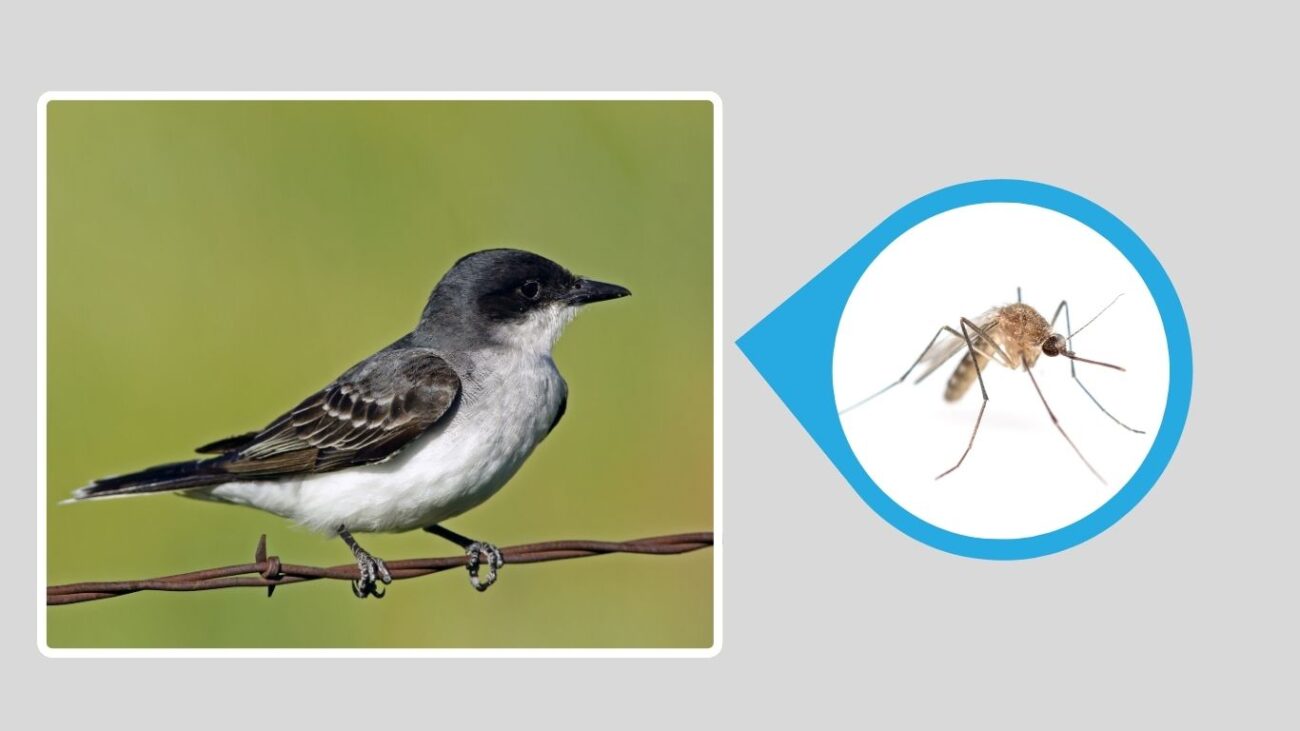
The Eastern Kingbird is an aggressive insect hunter that catches mosquitoes and other flying insects in midair with precision and speed. It’s one of the most active aerial feeders during mosquito season.
Identification and Appearance
- Dark gray to black back with white underparts
- Distinct white band at the tip of the tail
- Black head with a small red crown patch (often hidden)
- Strong, upright posture when perched
Feeding Habits and Mosquito Diet
Eastern Kingbirds feed heavily on flying insects, including mosquitoes, flies, and bees. They sally out from open perches to snatch insects mid-flight and return to the same spot repeatedly.
When and Where They Hunt
They’re most active during daylight hours, especially at dawn and dusk. Kingbirds prefer open fields, water edges, and woodland clearings where insects are abundant.
9. Bluebird (Eastern and Western)
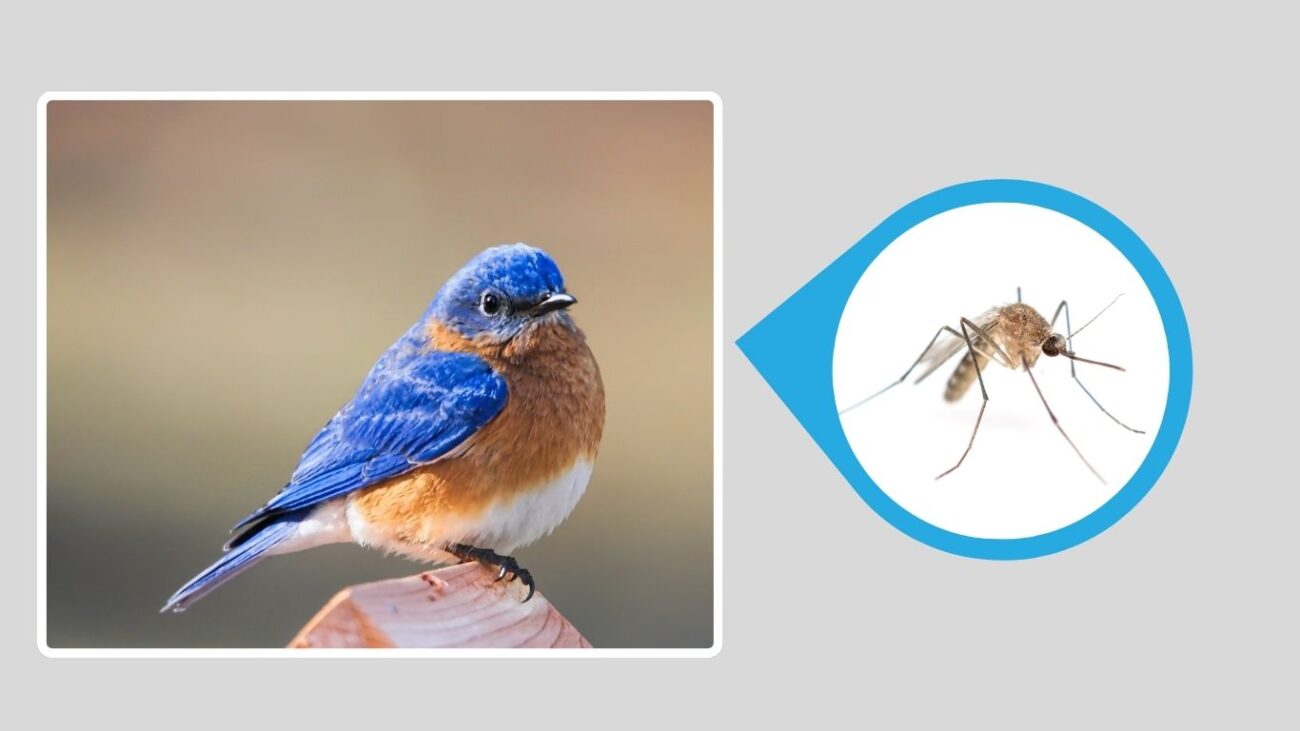
Both Eastern and Western Bluebirds help control mosquito populations by feeding on flying insects and larvae, particularly during the nesting season when they need protein for growing chicks.
Identification and Appearance
- Eastern Bluebird: Bright blue back and wings with a rusty-red chest
- Western Bluebird: Deeper blue with a more widespread rust on the chest and back
- Round head, short bill, and gentle expression
Feeding Habits and Mosquito Diet
Bluebirds primarily eat insects during spring and summer, including mosquitoes, caterpillars, beetles, and grasshoppers. They often hunt by dropping from a perch to the ground or catching insects midair.
When and Where They Hunt
Active during daylight hours in open meadows, orchards, and yards with scattered trees. Most foraging occurs in the morning and late afternoon when insects, including mosquitoes, are more active.
10. Red-eyed Vireo

The Red-eyed Vireo is a canopy-dwelling songbird known for tirelessly searching leaves and branches for insects, including mosquitoes and their larvae.
Identification and Appearance
- Olive-green back and wings
- White underparts and bold white eyebrow line bordered by black
- Red eyes (in adults)
- Slender body with a sharp, pointed bill
Feeding Habits and Mosquito Diet
This vireo feeds on a wide range of insects, such as caterpillars, beetles, flies, and mosquitoes. It gleans them from foliage and occasionally catches them in short aerial flights.
When and Where They Hunt
They are most active during the day, particularly in early morning and late afternoon. Found in deciduous forests, wooded parks, and along forest edges, they hunt high in the canopy where insects are abundant.
11. Nighthawk

Nighthawks are twilight and nighttime feeders that specialize in catching flying insects like mosquitoes, moths, and beetles with their wide, gaping mouths.
Identification and Appearance
- Mottled gray, brown, and white plumage
- Long, pointed wings with a white wing patch
- Forked tail and short bill with a very large mouth
- Erratic, fluttering flight style
Feeding Habits and Mosquito Diet
Nighthawks feed almost exclusively on flying insects. They swoop through the air at dusk and dawn, consuming hundreds of mosquitoes in a single feeding session.
When and Where They Hunt
Most active at twilight and during the night. Found in open habitats like cities, grasslands, and agricultural areas where streetlights or open skies attract insect swarms.
12. Yellow Warbler

The Yellow Warbler is a vibrant and energetic songbird that actively hunts small insects, including mosquitoes, especially during the breeding season.
Identification and Appearance
- Bright yellow body with faint reddish streaks on the chest (male)
- Olive-toned wings and tail
- Round head, thin bill, and dark eyes
- Slightly more muted yellow in females
Feeding Habits and Mosquito Diet
Yellow Warblers forage among leaves and branches for insects, targeting mosquitoes, midges, and small larvae. Their constant motion helps them find prey in dense foliage.
When and Where They Hunt
They hunt during daylight, especially in the early morning. These warblers are commonly found near wetlands, riverbanks, and shrubby woodlands — places where mosquitoes are plentiful.
13. Downy Woodpecker
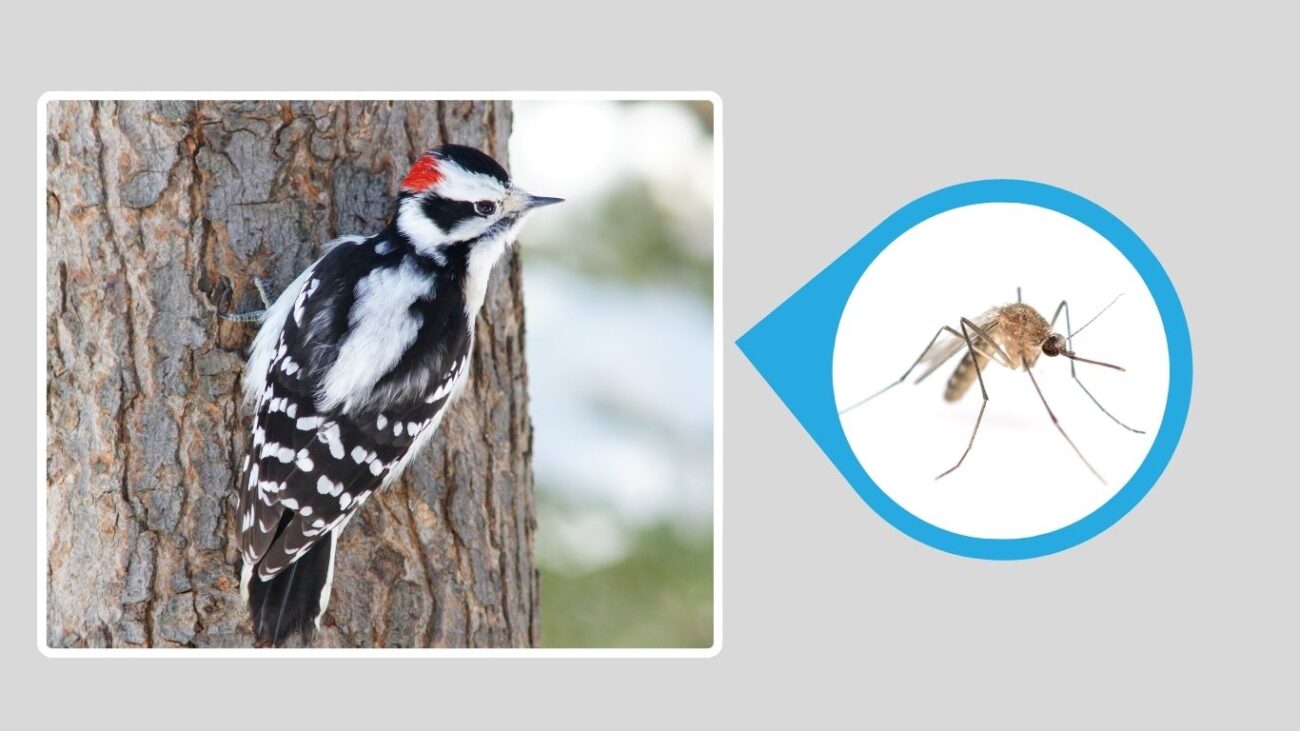
The Downy Woodpecker is the smallest North American woodpecker and helps control mosquito populations by feeding on larvae hidden in bark and wood crevices.
Identification and Appearance
- Black and white plumage with a checkered pattern
- Small red patch on the back of the male’s head
- Short bill and compact body
- White underside and black wings with white spots
Feeding Habits and Mosquito Diet
Primarily insectivorous, Downy Woodpeckers eat mosquito larvae found in rotting wood or tree bark. They use their chisel-like bills to extract hidden insects.
When and Where They Hunt
They forage during the day, often in wooded areas, orchards, and gardens. Their constant tapping and climbing behavior make them efficient insect hunters, especially in older trees and logs.
Would you like the final two birds?
14. Baltimore Oriole
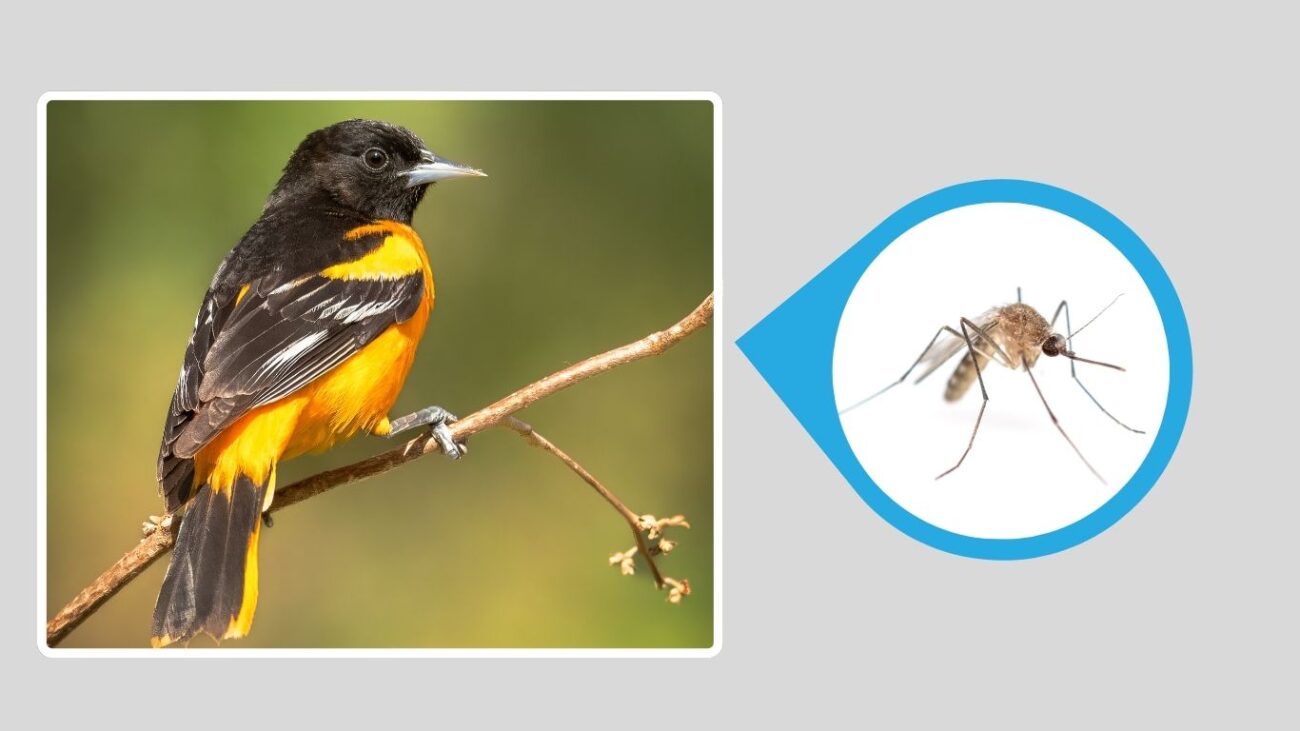
The Baltimore Oriole is a strikingly colorful bird that feeds on a variety of insects, including mosquitoes, especially during nesting season when high-protein prey is essential.
Identification and Appearance
- Male: Bright orange underparts with black head and back
- Female: Yellow-orange body with grayish wings
- Both have long, pointed bills and a sleek profile
Feeding Habits and Mosquito Diet
Baltimore Orioles hunt mosquitoes and other small insects by foraging through leaves and branches. They also catch flying insects midair and may feed on mosquito larvae near water sources.
When and Where They Hunt
Active during the day, especially in the early morning. They are commonly found in woodlands, gardens, and near water — ideal mosquito-rich environments.
15. American Robin

Though best known for pulling earthworms from the ground, the American Robin also eats a variety of insects, including mosquitoes, especially during warmer months.
Identification and Appearance
- Rusty-red breast, gray back, and dark head
- White around the eyes and on lower belly
- Upright stance with strong legs and medium-length tail
Feeding Habits and Mosquito Diet
Robins hunt mosquitoes by picking them off leaves or catching them during short flights. They also consume larvae and pupae found in damp vegetation or shallow water.
When and Where They Hunt
They forage throughout the day, especially in the morning and after rain. Found in backyards, parks, meadows, and forests — places where mosquitoes often breed.
Summary
From agile aerial hunters like Purple Martins and Barn Swallows to ground foragers like American Robins, these 15 birds offer natural mosquito control. Some specialize in catching mosquitoes midair, while others pick larvae from leaves, water, or wood. Active in different habitats and times of day, they each contribute to keeping mosquito populations in check. Encouraging these birds in your area by planting trees or setting up feeders can be an eco-friendly way to enjoy a mosquito-free environment.

